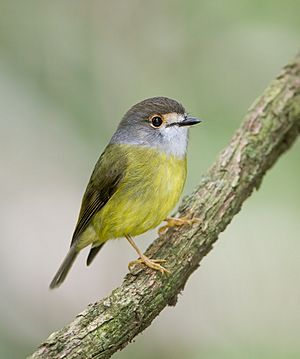Pale-yellow robin facts for kids
Quick facts for kids Pale-yellow robin |
|
|---|---|
 |
|
| Subspecies capito | |
| Conservation status | |
| Scientific classification | |
| Genus: |
Tregellasia
|
| Species: |
capito
|
The pale-yellow robin (Tregellasia capito) is a small, shy bird. It is a type of passerine bird, which means it's a perching bird. This robin belongs to the Petroicidae family. You can only find this bird in eastern Australia. Its favorite home is in warm, wet lowland forests.
This bird has a quiet look. It has a grey head and olive-green upper parts. Its throat is white, and its belly is yellow. Male and female pale-yellow robins look very much alike. They mostly eat insects.
Contents
Understanding the Pale-yellow Robin's Family Tree
Scientists group living things together in a system called "taxonomy." The pale-yellow robin was first described by a bird expert named John Gould in 1854. For many years, it was grouped with other yellow robins. This was because they looked alike and had similar nests and behaviors.
However, scientists later decided that the pale-yellow robin and its close relative, the white-faced robin, were special. They were placed in their own small group, or genus, called Tregellasia. This genus was created by Gregory Mathews in 1912.
Just like all Australian robins, this bird is not closely related to the European robin or the American robin. Instead, it belongs to a larger group of birds called Corvida. This group includes many tropical and Australian birds. Some of these are pardalotes, fairy-wrens, and honeyeaters. Even crows are in this big group!
People have also called this bird the "large-headed robin" or "pale robin."
Different Types of Pale-yellow Robins
There are two main types, or subspecies, of the pale-yellow robin:
- T. c. capito is the type found in rainforests. You can find it in northeastern New South Wales and southeastern Queensland. This subspecies is larger than the northern one. It has a paler, off-white face. It is not very common in its home range.
- T. c. nana was described in 1878. It is found in rainforests in far north Queensland. This subspecies is smaller than the southern one. Its name nana means 'dwarf' in Latin. It has a pale tan face and a light orange-brown ring around its eye. This is why some call it the "buff-faced" or "rufous-lored robin." It is quite common where it lives.
What Does the Pale-yellow Robin Look Like?
Both male and female pale-yellow robins look very similar. They are small birds, measuring about 12 to 13.5 centimeters (around 5 inches) long. They weigh between 15 and 18 grams (about 0.5 to 0.6 ounces).
This bird has a calm appearance. Its head and the back of its neck are grey. These colors blend into olive-green on its upper body. Its wings and tail are a bit more brownish. The throat is white. The area around its eyes is off-white in the southern type and buff in the northern type. Its chest and belly are bright yellow. The legs are yellow-orange, and its eyes are dark brown. It has a thin black beak about 1.5 centimeters (0.6 inches) long.
Young pale-yellow robins are reddish-brown with lighter stripes on their heads. You can tell it apart from the eastern yellow robin because the eastern yellow robin has black legs and is a bit bigger.
The pale-yellow robin makes a trilling sound. It uses this call when it is showing off or protecting its home.
Where the Pale-yellow Robin Lives
The pale-yellow robin stays in the same area for its whole life. You can find it from Mount Amos to Paluma in North Queensland. It also lives from Cooloola on the Sunshine Coast south to Barrington Tops National Park in New South Wales.
It loves living in rainforests or thick eucalyptus forests. It especially likes places where the lawyer vine grows.
How the Pale-yellow Robin Behaves
The pale-yellow robin spends most of its time in trees. It is a very secretive bird. It mainly eats insects. Sometimes, it might also eat seeds to add to its diet.
Reproduction and Life Cycle
This bird uses the prickly lawyer vine (Calamus muelleri) to build its nest. It also chooses the vine as a good place for its nest. The nest can be as high as 10 meters (30 feet) off the ground. But often, it builds its nest much lower.
The breeding season for the pale-yellow robin is from July to December. They usually have one group of babies, but sometimes two. They lay two oval-shaped eggs. Each egg measures about 20 by 15 millimeters (0.8 by 0.6 inches). The eggs are pale green with brownish spots.
See also
 In Spanish: Petroica amarillenta para niños
In Spanish: Petroica amarillenta para niños


